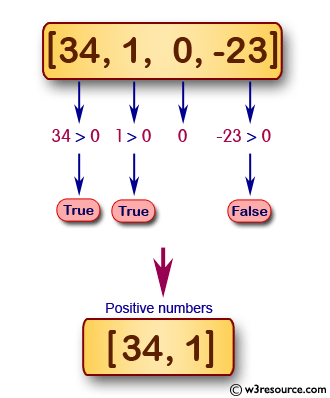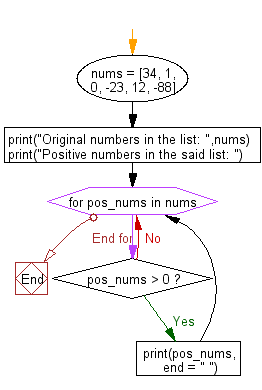Python: Filter the positive numbers from a list
Python Basic: Exercise-114 with Solution
Write a Python program to filter the positive numbers from a list.
Positive Numbers: Any number above zero is known as a positive number. Positive numbers are written without any sign or a '+' sign in front of them and they are counted up from zero, i.e. 1, + 2, 3, +4 etc.
Pictorial Presentation:

Sample Solution-1:
Python Code:
nums = [34, 1, 0, -23, 12, -88]
print("Original numbers in the list: ",nums)
new_nums = list(filter(lambda x: x >0, nums))
print("Positive numbers in the said list: ",new_nums)
Sample Output:
Original numbers in the list: [34, 1, 0, -23, 12, -88] Positive numbers in the said list: [34, 1, 12]
Visualize Python code execution:
The following tool visualize what the computer is doing step-by-step as it executes the said program:
Sample Solution-2:
Python Code:
nums = [34, 1, 0, -23, 12, -88]
print("Original numbers in the list: ",nums)
print("Positive numbers in the said list: ")
for pos_nums in nums:
if pos_nums > 0:
print(pos_nums, end = " ")
Sample Output:
Original numbers in the list: [34, 1, 0, -23, 12, -88] Positive numbers in the said list: 34 1 12
Flowchart:

Visualize Python code execution:
The following tool visualize what the computer is doing step-by-step as it executes the said program:
Sample Solution-3:
Python Code:
nums = [34, 1, 0, -23, 12, -88]
print("Original numbers in the list: ",nums)
pos_nums = [n for n in nums if n> 0]
print("Positive numbers in the said list: ",*pos_nums)
Sample Output:
Original numbers in the list: [34, 1, 0, -23, 12, -88] Positive numbers in the said list: 34 1 12
Visualize Python code execution:
The following tool visualize what the computer is doing step-by-step as it executes the said program:
Python Code Editor:
Have another way to solve this solution? Contribute your code (and comments) through Disqus.
Previous: Write a Python program to input a number, if it is not a number generates an error message.
Next: Write a Python program to compute the product of a list of integers (without using for loop).
What is the difficulty level of this exercise?
Test your Programming skills with w3resource's quiz.
Python: Tips of the Day
Find current directory and file's directory:
To get the full path to the directory a Python file is contained in, write this in that file:
import os dir_path = os.path.dirname(os.path.realpath(__file__))
(Note that the incantation above won't work if you've already used os.chdir() to change your current working directory, since the value of the __file__ constant is relative to the current working directory and is not changed by an os.chdir() call.)
To get the current working directory use
import os cwd = os.getcwd()
Documentation references for the modules, constants and functions used above:
- The os and os.path modules.
- The __file__ constant
- os.path.realpath(path) (returns "the canonical path of the specified filename, eliminating any symbolic links encountered in the path")
- os.path.dirname(path) (returns "the directory name of pathname path")
- os.getcwd() (returns "a string representing the current working directory")
- os.chdir(path) ("change the current working directory to path")
Ref: https://bit.ly/3fy0R6m
- New Content published on w3resource:
- HTML-CSS Practical: Exercises, Practice, Solution
- Java Regular Expression: Exercises, Practice, Solution
- Scala Programming Exercises, Practice, Solution
- Python Itertools exercises
- Python Numpy exercises
- Python GeoPy Package exercises
- Python Pandas exercises
- Python nltk exercises
- Python BeautifulSoup exercises
- Form Template
- Composer - PHP Package Manager
- PHPUnit - PHP Testing
- Laravel - PHP Framework
- Angular - JavaScript Framework
- Vue - JavaScript Framework
- Jest - JavaScript Testing Framework
